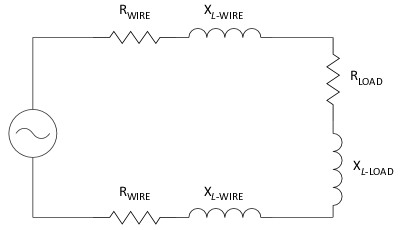Incorrect.
I guessed it wrong from
Effective Z = RcosΘ + XsinΘ
:slaphead:
Incorrect.
Effective Z = RcosΘ + XsinΘ
I should have noted that those were for 85% p.f.At 85?F here are the copper R to effective Z percentages in three conduit types:
If you were here, I'd say you had not had time for coffee. I guess we will call it the effects of a long day since it is quittin' time over there.I guessed it wrong
It is from the approximate formula for voltage drop:mivey:
Still, is it correct 'Effective Z = RcosΘ + XsinΘ?' How did you derive it?
While all values required for in the exact expression for Vdrop =I*Z, where I is load current and Z =[||Z|cosΘ +j|Z|sinΘ|]=[(R2+X2)1/2] is impedance of the circuit, can be obtained from the right hand side of the approximate expression Vdrop = I*(RcosΘ + X sinΘ), I wonder why the approximate expression need be used for calculation of Vdrop.It is from the approximate formula for voltage drop:
Vdrop = I*(RcosΘ + X sinΘ)
FWIW, the exact formula is:
Vdrop = Vsending + I*(RcosΘ + X sinΘ) - sqrt(Vsending2 - (IRcosΘ - IX sinΘ)2 )
All of which show R ≤ Z.At 85?F here are the copper R to Z percentages in three conduit types:
By definition that will always be the case. Not so for "effective Z" (NEC term) which is simply a voltage drop factor.All of which show R ≤ Z.
OK.By definition that will always be the case. Not so for "effective Z" (NEC term) which is simply a voltage drop factor.
Don't forget that when you calculate VD=IZ that you are removing the impedance of the load from the calculation. The load is the main constituent of the circuit's power factor. That's why you have to use ZEFFECTIVE. As to a practical application with real numbers...OK.
Voltage drop is IZ. Current times impedance. If R ≤ Z always, why, how, can IR ever exceed IZ?
Maybe an example of a practical application with actual numbers would be helpful.

Not quite. One is a voltage vector the other is a comparison of magnitudes.Voltage drop is IZ.
You know the magnitude of I but you don't know the angle. Iterating should find the value.Maybe an example of a practical application with actual numbers would be helpful.
Per NEC Table 9, 8AWG copper conductors in steel conduit...... As to a practical application with real numbers...
Don't forget that when you calculate VD=IZ that you are removing the impedance of the load from the calculation. The load is the main constituent of the circuit's power factor. That's why you have to use ZEFFECTIVE. As to a practical application with real numbers...
And you're not going to. I'm leaving it as an exercise for the doubter(s)I don't see the real numbers in your post. ...
Answer this, given the numbers above for 8AWG... How can XL cause a 0.85PF?...
If the only anomaly is taking into consideration or removing the load impedance, the observed difference for larger wires would have to come either from skin effect or the changing magnitude of XL-wire on the larger conductors.
the exact formula is:
Vdrop = Vsending + I*(RcosΘ + X sinΘ) - sqrt(Vsending2 - (IRcosΘ - IX sinΘ)2 )
Another typo...Formula typo. The correct formula is:
Vdrop = Vsending + I*(RcosΘ + X sinΘ) - sqrt(Vsending2 - (IXcosΘ - IRsinΘ)2)
It does not matter since the approximate formula as used in the NEC is still used and given in the red book.(note to mivey: FWIW, and don't know if it makes much difference, but Table 9 was developed long before IEEE revised its voltage drop formula to the current "exact formula".)
I figured out my mistake. I used the Θ from the voltage and current across the load instead of the load impedance. Now all is good. Latest calc:With iteration I got a 5.223 volt drop instead of a 5.204 volt drop (the exact formula result). Not sure what I missed

